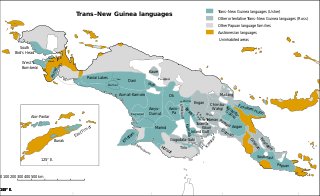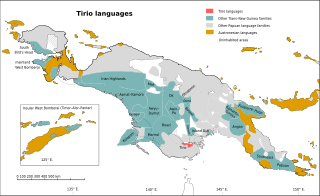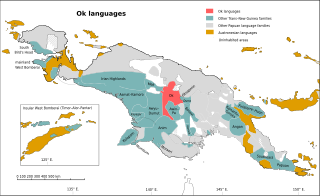
Trans–New Guinea (TNG) is an extensive family of Papuan languages spoken in New Guinea and neighboring islands, perhaps the third-largest language family in the world by number of languages. The core of the family is considered to be established, but its boundaries and overall membership are uncertain. The languages are spoken by around 3 million people. There have been three main proposals as to its internal classification.

The Trans-Fly – Bulaka RiverakaSouth-Central Papuan languages form a hypothetical family of Papuan languages. They include many of the languages west of the Fly River in southern Papua New Guinea into southern Indonesian West Papua, plus a pair of languages on the Bulaka River a hundred km further west.

The Marind–Yaqai (Marind–Yakhai) languages are a well established language family of Papuan languages, spoken by the Marind-anim. They form part of the Trans–New Guinea languages in the classifications of Stephen Wurm and Malcolm Ross, and were established as part of the Anim branch of TNG by Timothy Usher.
The Pauwasi languages are a likely family of Papuan languages, mostly in Indonesia. The subfamilies are at best only distantly related. The best described Pauwasi language is Karkar, across the border in Papua New Guinea. They are spoken around the headwaters of the Pauwasi River in the Indonesian-PNG border region.

The Mek languages are a well established family of Papuan languages spoken by the Mek peoples. They form a branch of the Trans–New Guinea languages (TNG) in the classifications of Stephen Wurm (1975) and of Malcolm Ross (2005).

The South Bird's Head or South Doberai languages are three families of Papuan languages. They form part of the Trans–New Guinea languages in the classifications of Malcolm Ross (2005) and Timothy Usher (2020), though Pawley and Hammarström (2018) do not consider them to be part of Trans–New Guinea.
The Dani or Baliem Valley languages are a family of clearly related Trans–New Guinea languages spoken by the Dani and related peoples in the Baliem Valley in the highlands of Papua Province, Indonesia. Foley (2003) considers their TNG status to be established. They may be most closely related to the languages of Paniai Lakes, but this is not yet clear. Capell (1962) had posited that their closest relatives were the Kwerba languages, which Ross (2005) rejects.
The Timor–Alor–Pantar (TAP) languages are a family of Papuan (non-Austronesian) languages spoken in Timor, Kisar, and the Alor archipelago in Southern Indonesia.
The Kutubuan languages are a small family of neighboring languages families in Papua New Guinea. They are named after Lake Kutubu in Papua New Guinea.

The Turama–Kikorian languages are a family identified by Arthur Capell (1962) and part of the Trans–New Guinea languages (TNG) family in the classifications of Stephen Wurm (1975) and Malcolm Ross (2005). The family is named after the Turama River and Kikori River of southern Papua New Guinea; the alternative name is based more narrowly on the Omati River.

The Teberan languages are a well established family of Papuan languages that Stephen Wurm (1975) grouped with the Pawaia language as a branch of the Trans–New Guinea phylum.

The Tirio languages are a family of Trans–New Guinea languages in the classification of Malcolm Ross. The Tirio languages have about 40% of their lexicon in common.

The Ok languages are a family of about a dozen related Trans–New Guinea languages spoken in a contiguous area of eastern Irian Jaya and western Papua New Guinea. The most numerous language is Ngalum, with some 20,000 speakers; the best known is probably Telefol.

The Madang or Madang–Adelbert Range languages are a language family of Papua New Guinea. They were classified as a branch of Trans–New Guinea by Stephen Wurm, followed by Malcolm Ross. William A. Foley concurs that it is "highly likely" that the Madang languages are part of TNG, although the pronouns, the usual basis for classification in TNG, have been "replaced" in Madang. Timothy Usher finds that Madang is closest to the Upper Yuat River languages and other families to its west, but does not for now address whether this larger group forms part of the TNG family.

The Kainantu–Goroka language are a family of Papuan languages established by Arthur Capell in 1948 under the name East Highlands. They formed the core of Stephen Wurm's 1960 East New Guinea Highlands family, and are one of the larger branches of Trans–New Guinea in the 2005 classification of Malcolm Ross.

The Finisterre–Huon languages comprise the largest family within the Trans–New Guinea languages (TNG) in the classification of Malcolm Ross. They were part of the original TNG proposal, and William A. Foley considers their TNG identity to be established. The languages share a small closed class of verbs taking pronominal object prefixes some of which are cognate, strong morphological evidence that they are related.

Sumuri or Sumeri is a language spoken in Sumuri District, Teluk Bintuni Regency on the Bomberai Peninsula by about a thousand people.
The Orya–Tor languages are a family of just over a dozen Papuan languages spoken in Western New Guinea, Indonesia.
Foi, also known as Foe or Mubi River, is one of the two East Kutubuan languages of the Trans-New Guinea family spoken along Lake Kutubu and Mubi River, located in the Southern Highlands Province of Papua New Guinea. Dialects of Foi are Ifigi, Kafa, Kutubu, Mubi. A Swadesh list for the Foi language was documented by The Rosetta Project in 2010. The estimated number of Foi speakers as of 2015 is between 6,000 and 8,000.
The Kwerbic, or Greater Kwerba, languages are a family of just under a dozen Papuan languages spoken in Indonesia.













